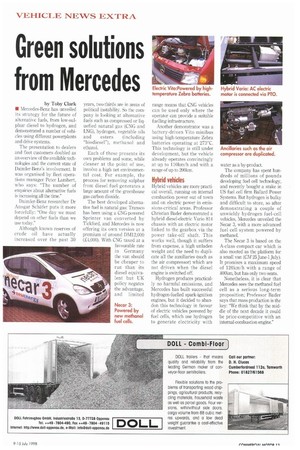Green solutions from Mercedes
Page 15

If you've noticed an error in this article please click here to report it so we can fix it.
by Toby Clark • Mercedes-Benz has unveiled its strategy for the future of alternative fuels, from low-sulphur diesel to hydrogen, and demonstrated a number of vehicles using different powerplants and drive systems.
The presentation to dealers and fleet customers doubled as an overview of the available technologies and the current state of Daimler-Benz's involvement. It was organised by fleet operations manager Peter Lambert, who says: "The number of enquiries about alternative fuels is increasing all the time."
Daimler-Benz researcher Dr Ansgar Schafer puts it more forcefully: "One day we must depend on other fuels than we use today."
Although known reserves of crude oil have actually increased over the past 30 years, two-thirds are in areas of political instability. So the company is looking at alternative fuels such as compressed or liquefied natural gas (CNG and LNG), hydrogen, vegetable oils and esters (including "biodiesel"), methanol and ethanol.
Each of these presents its own problems and some, while cleaner at the point of use, involve a high net environmental cost. For example, the process for removing sulphur from diesel fuel generates a large amount of the greenhouse gas carbon dioxide.
The best developed alternative fuel is natural gas: Transco has been using a CNG-powered Sprinter van converted by Tickford, and Mercedes is now offering its own version at a premium of around DM12,000 (£4,000). With CNG taxed at a favourable rate in Germany the van should be cheaper to run than its diesel equivalent but UK policy negates the advantage, and limited range means that CNG vehicles can be used only where the operator can provide a suitable fuelling infrastructure.
Another demonstrator was a battery-driven Vito minibus using high-temperature Zebra batteries operating at 273°C. This technology is still under development, but the vehicle already operates convincingly at up to 110knith and with a range of up to 200km.
Hybrid vehicles
Hybrid vehicles are more practical overall, running on internal combustion power out of town and on electric power in emissions-critical areas. Professor Christian Bader demonstrated a hybrid diesel-electric Vario 814 chassis with an electric motor linked to the gearbox via the power take-off shaft. This works well, though it suffers from expense, a high unladen weight and the need to duplicate all the auxiliaries (such as the air compressor) which are not driven when the diesel engine is switched off.
Hydrogen produces practically no harmful emissions, and Mercedes has built successful hydrogen-fuelled spark-ignition engines, but it decided to abandon this technology in favour of electric vehicles powered by fuel cells, which use hydrogen to generate electricity with water as a by-product.
The company has spent hundreds of millions of pounds developing fuel cell technology, and recently bought a stake in US fuel cell firm Ballard Power Systems. But hydrogen is bulky and difficult to store, so after demonstrating a couple of unwieldy hydrogen fuel-cell vehicles, Mercedes unveiled the Necar 3, with a more advanced fuel cell system powered by methanol.
The Necar 3 is based on the A-class compact car which is also mooted as the platform for a small van (CM 25 June-1 July). It promises a maximum speed of 120km/h with a range of 400km, but has only two seats.
Nonetheless, it is clear that Mercedes sees the methanol fuel cell as a serious long-term proposition; Professor Bader says that mass production is the key: "We think that by the middle of the next decade it could he price-competitive with an internal-combustion engine."












































































































